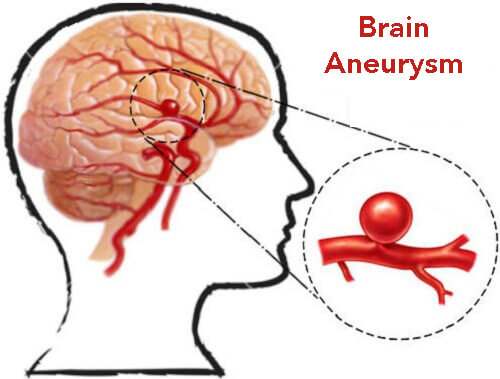Brain Aneurysm Causes, Symptoms, Diagnosis and Treatment

What Is A Brain Aneurysm?
A brain (cerebral) aneurysm is a bulging, weak area in the wall of an artery that supplies blood to the brain.
In most cases, a brain aneurysm causes no symptoms and goes unnoticed.
In rare cases, the brain aneurysm ruptures, releasing blood into the skull and causing a stroke.
When a brain aneurysm ruptures, the result is called a subarachnoid hemorrhage. Depending on the severity of the hemorrhage, brain damage or death may result.
Treatment for an unruptured brain aneurysm may be appropriate in some cases and may prevent a rupture in the future.
Complications that can develop after the rupture of an aneurysm include:
- Re-bleeding.
Re-bleeding can cause further damage to brain cells. - Vasospasm.
This condition can limit blood flow to brain cells (ischemic stroke) and cause additional cell damage and loss. - Hydrocephalus.
This is marked by blocked circulation of the fluid surrounding the brain and spinal cord (cerebrospinal fluid).
Causes Of Brain Aneurysms:
Brain aneurysms develop as a result of thinning artery walls.
Although aneurysms can appear anywhere in the brain, they are most common in arteries at the base of the brain.
Possible Risk Factors Of Brain Aneurysms:
- Family history.
People who have a family history of brain aneurysms are more likely to have an aneurysm than those who don’t. - Previous aneurysm.
People who have had a brain aneurysm are more likely to have another. - Gender.
Women are more likely to develop a brain aneurysm or to suffer a subarachnoid hemorrhage. - Race.
African Americans are more likely than whites to have a subarachnoid hemorrhage. - High blood pressure.
The risk of subarachnoid hemorrhage is greater in people who have a history of high blood pressure. - Smoking.
The use of cigarettes may greatly increase the chances of a brain aneurysm rupturing.
Symptoms Of Brain Aneurysms:
Symptoms vary as per the type of aneurysm.
- Ruptured aneurysm
Sudden, extremely severe headache
Nausea and vomiting
Stiff neck
Blurred or double vision
Sensitivity to light
Seizure
A drooping eyelid
Loss of consciousness
Confusion - Leaking aneurysm
Sudden, extremely severe headache - Unruptured aneurysm
Pain above and behind an eye
A dilated pupil
Change in vision or double vision
Numbness, weakness or paralysis of one side of the face
A drooping eyelid
Diagnosis Of Brain Aneurysm:
The following test help confirm the diagnosis of brain aneurysm:
- Computerized tomography (CT).
- Cerebrospinal fluid test.
Lumbar puncture or spinal tap. - Magnetic resonance imaging (MRI).
- Cerebral angiogram.
Treatment Of Brain Aneurysm:
The following treatment options are available:
- Surgery
1. Surgical clipping is a procedure to close off an aneurysm.
2. Endovascular coiling is a less invasive procedure than surgical clipping. - Pain relievers, such as acetaminophen (Tylenol, others), may be used to treat headache pain.
- Calcium channel blockers prevent calcium from entering cells of the blood vessel walls.
- Interventions to prevent stroke from insufficient blood flow include intravenous injections of a drug called a vasopressor, which elevates blood pressure to overcome the resistance of narrowed blood vessels.
- Anti-seizure medications may be used to treat seizures related to a ruptured aneurysm.
Levetiracetam (Keppra),
phenytoin (Dilantin, Phenytek, others),
Valproic acid (Depakene) and others. - Ventricular or lumbar draining catheters and shunt surgery can lessen pressure on the brain from excess cerebrospinal fluid (hydrocephalus) associated with a ruptured aneurysm.
- Rehabilitative therapy. Damage to the brain from a subarachnoid hemorrhage may result in the need for physical, speech and occupational therapy to relearn skills.
By : Natural Health News




